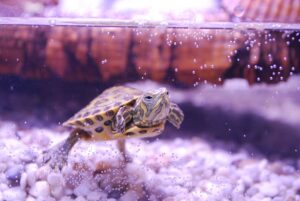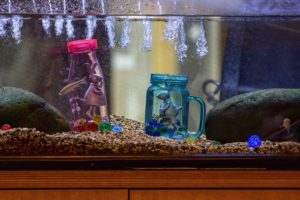Believe it or not – almost every pet owner has a fish tank that’s not being used. From time to time, these fish tank owners begin to wonder if they can turn their tanks into reptile tanks.
So is it possible? Can you turn a fish tank into a reptile tank?
In this article, I will cover the following:
- The difference between fish tanks and reptile tanks
- If utilizing fish tanks as reptile tanks is a possibility
- The steps into transforming it
Are you ready to get started?
Can You Turn A Fish Tank Into A Reptile Tank?

Owning and loving aquarium pets is one of the best pleasures in life. You get to care for a tiny, living creature and witness it grow.
Designing and decorating their tanks can be the most enjoyable experience.
However, there could be a scenario where you find your tank is not useful anymore; you lost your fish and now you find your preferences leaning towards a reptile.
So what about that empty fish tank you still have but is not being utilized?
Well, why not transform that into a reptile tank? But is that even possible? Quick answer: yes. But there’s a lot that goes into this process.
I have deciphered every aspect that could pertain to this transformation. From understanding the basic difference between these tanks, their functioning, and ultimately the details on how to achieve this task.
Difference Between Fish Tanks And Reptile Tanks

The very basic difference between the two is that fish tanks, also called aquariums, are built to enclose water with fish and sea creatures while reptile tanks also called terrariums are commonly for reptiles and plants.
Hence, an aquarium, at the core, is waterproof while a reptile terrarium incorporates a drain and cavities for air circulation.
Let’s dive in some more so you can comprehend the differences better.
- Fish tanks are all about an impenetrable environment where the water is 100% contained inside the tank. Reptile tanks, on the contrary, are not built for keeping water. They will generally include plants or reptiles such as snakes, lizards, chameleons, and so on, so they do not need to be waterproof but they absolutely need air circulating throughout the tank system, from bottom to top as well.
- Another main dissimilarity is temperature. You cannot surmise that the temperature will be the same in the aquarium as well as the reptile terrarium because the walls of a fish tank are considerably thicker, that’s why you cannot exactly tell the temperature. While aquariums, in general, are kept in cooler environments, reptile tanks need warmth.
- Fish tanks are approximately five-sided thick glass containers constructed to carry water, reptile tanks are enclosures made out of thinner glass designed for smaller animals and for better viewing.
Understanding these major differences in the way both of these tanks work is of the utmost significance before taking up the transformation.
Is It Possible?

Now that all the disparities between the two tanks have been defined, let’s get back to the main question. Is this conversion possible?
The short and optimistic answer is yes but the actual answer is that it will need a lot of work and dedication.
But worry not as I aim to explain everything. Making this transformation happen essentially requires a lot of modifications that need to be tailored to your reptile’s specific needs.
So no matter what kind of reptile you plan to keep, aquariums will need revisions before being used.
Requirement During Transformation
Mainly, a screened lid is the most important part that must supplant the glass top used with fish.
The top cannot have sharp edges and needs to be able to clasp securely into place to prevent any escaping adventures of your reptile.
Other elements will include the basking lamps, oxygen outlets to name a few.
Step-By-Step Guide For Your Transformation

Step 1: Setting Up The Tank
First off, you need to thoroughly clean the glass if the fish tank has been used, simple soap and water will suffice. Ensure that all the cleaning material is rinsed thoroughly from the tank and it is dried properly.
Then decide upon which side will be hot and which will be cold for it is crucial to have temperature gradients so your reptile can self-regulate its body temperature. You will need to buy a heat mat that must be placed under the tank so your pet does not burn itself.
Step 2: Substrate Addition
The next step will be to put in the substrate. Go with a textured mat as it will enable you to view your pet easily, and find it when it needs to be taken out for maintenance. You can also add some moss throughout the habitat for your reptile to burrow in.
Although, you can also use some other variety of substrate, namely aspen chips.
Step 3: Bring In The Decorations
Now you can let your creativity run wild, but do ensure to have a hiding spot for both hot and cold sides as it makes the reptile get less stressed and aids them in feeling secure when they need to adjust to a new environment.
- Add in fake plants to make it feel more at home but arrange them smartly so they don’t come in the way.
- Make sure to have a water dish and change it regularly.
Step 4: Lighting And Heating
As reptiles are cold-blooded, they crave warmth and it is your job to provide it.
You can now put the screen top and lighting. Locking tops are highly advised to confirm that your reptile remains inside. Heat lighting must be added above the heat mat and on the hot side. The level of temperature, however, depends on the kind of reptile.
Step 5: Maintenance
With everything done, take special care of the preservation of your terrarium. Use a tub with locks and air holes when you need to take the reptile out or use any other substance in which it can crawl freely.
- It is vital to keep the tank tidy and restore the substrate as it gets dirty.
From VivariumTips,
Now that I have incorporated everything into this article, so while this transition is indeed possible, it comes with a lot of learning and labor. Recognizing all these factors will assist you in getting on with this process by adopting the most suitable practices.
Follow all these instructions responsibly and voila, you now are the proud owner and creator of a reptile tank.
So if you end up succeeding with every step and emerge triumphantly, be very mindful of the maintenance factor. Keep your pets in the most appropriate conditions needed for their survival.
If you enjoyed this article, you might also like:
- How To Catch Springtails in The Wild?
- What Can I Use Instead of Distilled Water?
- Must-Know Facts During Your Paludarium Construction
The best way to support this blog and continue receiving free information is to share any articles on this website with your friends! 🙂
